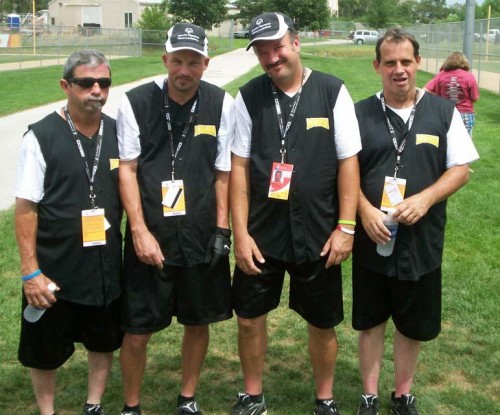
Terrebonne special athletes go for gold
September 21, 2010
Geraldine Spencer
September 23, 2010Step one: Contain the spill. Done.
Step two: Cap the well. Done.
Step three: Kill the well. Done, finally.
Logic would deem lifting the moratorium the next step in reaction to BP’s Deepwater Horizon disaster. It’s set to run through Nov. 30, but with fall elections set for early November, locals are hopeful the Obama administration will show mercy on the oil and gas industry.
“The moratorium might nominally be lifted before the end of November just so [the administration] can say they did their best to expedite things,” said Eric Smith, a clinical finance professor at Tulane Energy Institute. I think most people are hoping it doesn’t go beyond that date, especially given the defacto moratorium on shallow-water drilling.”
In the five months since the Deepwater explosion, those in the oil and gas industry have found themselves tested to the core. A moratorium initially on deepwater oil exploration, but later extended to all drilling, has left oil and gas companies spending money daily while crews wait for the go-ahead to work.
All the while, pleas from state and local officials and those involved with oil and gas have fallen on seemingly deaf ears.
“We certainly hope it’s not Dec. 1 before the moratorium is lifted,” said Chris John, president of Louisiana Mid-Continent Oil and Gas Association. The organization has been working with the Bureau of Ocean Energy Management, Regulation and Enforcement to resolve concerns before the moratorium deadline date.
John said four task forces – one specific to the regulations in the Gulf of Mexico – have been developed in Washington, D.C.
In the aftermath of the BP incident, four major players in the oil and gas industry – Exxon-Mobile, Chevron, Shell and Conoco Phillips – put up $1 billion to set up a marine containment spill company. “In a nutshell, it sets up a repository or warehousing of pre-engineered, prefabricated equipment to handle any kind of incident with a well head accident like we had with the Deepwater Horizon. Coupling, fittings, riser pipes in a warehouse … ready to go,” John said.
And Monday, BP actually announced it was joining the proposed Marine Well Containment Company and making the equipment used to contain the Monacondo well available to all oil and gas companies operating in the Gulf of Mexico.
The question many are left asking, however, is will it be enough?
“The oil and gas industry has done, I believe, everything that a) has been asked of them; and b) I think they’ve gone over and above to make sure something like this doesn’t happen again,” John said. “If it does, we are prepared to handle it in a much better way than we ever were.”
Bottom line, according to Don Briggs, president of the Louisiana Oil and Gas Association, the damage … to the Gulf of Mexico, the coastline and the industry itself has been done.
Briggs estimates as many as seven companies are working on plans to abandon drilling projects in the Gulf. However, only three have actually left: a Transocean rig and two Diamond rigs are headed to Egypt and the Congo.
“They can’t afford to sit there and pay the $350,000 or $400,000 a day that’s having to be paid while the rigs are idle,” he said.
South Louisiana’s challenge is luring companies into drilling in the Gulf of Mexico. In recent years, the number of oil firms drilling in shallow water has sharply declined. Four or five years ago, the Gulf had 140 to 150 rigs in operation, Briggs said. Today, the number is closer to 14.
And after the April 20th explosion, with the stroke of a pen, President Obama discounted the biggest asset the Gulf afforded oil exploration companies: Political stability.
“If companies had a rig working here [in the Gulf], they would put up with a little higher cost because they knew that they weren’t going to be subject to expropriation or stuff like that that happens in Venezuela,” Smith said.
Long considered “the single-most expensive place to find a barrel of oil,” according to Briggs, the Gulf of Mexico’s finding cost per barrel is approximately $64.
“In other parts of the world, the finding cost isn’t that great,” he said.
But with the seemingly anti-oil sentiment emanating from the White House, the state’s oil and gas association leaders fear the Gulf may have joined the ranks of the rest of the world in regard to political safe havens.
“Uncertainty,” Briggs said, “is the magic word.”
No one knows what to expect. New rules? Stiffer rules? Required modifications to rigs in operation? Or permission to work?
“I think that enters into some decisions that will be made by companies when they are looking at where they are going to put their capital dollars,” John said. “A lot of the major companies that explore and produce in the Gulf are billion dollar outfits and have billion dollar cap budgets. They could go anywhere in the world.
“I think that this uncertainty short-term that [the moratorium] has created is going to be very difficult, not only on the oil and gas companies but the hundreds of thousands of people in the support services,” he added.
Those are the people, too, that Smith argues may have been missed in the federal government’s recent report arguing that the moratorium hasn’t resulted in the “gloom and doom” many predicted.
According to the report, only 2,000 rig jobs have been lost and 8,000 onshore positions eliminated.
“But my assumptions are a little different,” Smith admits. “Their assumptions are pitched to support the government’s case. My assumptions were always based on what was the worst case scenario.”
Although Smith and the feds worked from the same data and multipliers, the Tulane professor said his early estimates were based on all 33 of the deepwater rigs leaving the Gulf of Mexico. “Obviously, they haven’t,” he said.
But factor in the unknowns – how quickly the deepwater rigs can resume operations and how soon shallow-water permits are issued, for example – and the calculations change. Also, the federal report tallied its economic impact through July, but the moratorium remains in effect and bills continue to mount.
“Short-term, long-term, I think the damage – whether we lift the moratorium today or Dec. 1 – already has been done. It’s going to take a very long time to heal.”
Smith is even less optimistic.
“Even if these rigs stay in the Gulf and are on standby, they are not drilling,” he said. “They don’t need drilling mud; they don’t need supply boats running back and forth; they don’t need drill pipe or cement. They still need food, so the caterers might still have some business.
“But business is off the pace on 31 rigs,” the professor continued. “There might be two or three rigs out there helping with the Monacando thing, but the rest of them are parked if they haven’t left.”
Smith describes the Obama administration’s latest tome a “very self-serving report” at best. “It’s not that anything they said is not likely or plausible,” he said. “It seems to be more an effort to shift the blame … to say that none of this was caused by the moratorium.”
Whatever comes next, John said the new regulations will have to be “reasonably vetted” before the moratorium is lifted. “What I envision is an NTL that is going to make all these requirements that are going to satisfy the administration, and then they are going to lift the moratorium,” he said. “I think that would be the more common path to take, but there is not a lot of common sense in that administration.”











